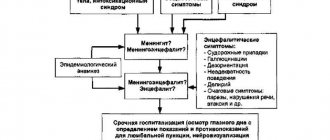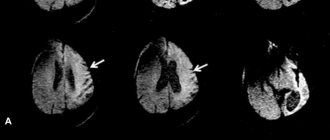Symptoms and treatment of tick-borne encephalitis
Tick-borne encephalitis is seasonal and appears only in the spring-summer period - the time of activation of tick activity. The carrier lives in grass and treetops, has very low mobility and does not have the ability to pursue its prey.
The tick clings to a person or animal located in close proximity to it and parasitizes on it for several days. They choose the least noticeable place for attachment - axillary and inguinal folds, knee bends, head, neck, so detecting a tick in the first days is very difficult. It can be detected several days later, after it increases in size several dozen times.
The ixodid tick itself is not a source of the virus - it becomes infected with it from sick animals. The total number of infected ticks is approximately 20%, so an arthropod bite does not always lead to infection.
What it is?
Tick-borne encephalitis (spring-summer tick-borne meningoencephalitis) is a natural focal viral infection characterized by fever, intoxication and damage to the gray matter of the brain (encephalitis) and/or the membranes of the brain and spinal cord (meningitis and meningoencephalitis). The disease can lead to persistent neurological and psychiatric complications and even death of the patient.
According to statistics, six ticks out of a hundred are carriers of the virus (at the same time, from 2 to 6% of people bitten can get sick from an infected individual).
How does infection occur?
The main reservoir and source of infection are ixodid ticks. How does the tick-borne encephalitis virus enter the insect's body? 5–6 days after the bite of an infected animal in a natural outbreak, the pathogen penetrates all organs of the tick and concentrates mainly in the reproductive and digestive systems, and the salivary glands. The virus remains there for the entire life cycle of the insect, which is from two to four years. And all this time, after a tick bites an animal or person, tick-borne encephalitis is transmitted.
Absolutely every resident of an area where there are outbreaks of infection can become infected. These statistics are disappointing for humans.
- Any animal can be a natural reservoir of infection: hedgehogs, moles, chipmunks, squirrels and voles and about 130 other species of mammals.
- Depending on the region, the number of infected ticks ranges from 1–3% to 15–20%.
- Some species of birds are also among the possible carriers - hazel grouse, finches, thrushes.
- According to epidemiology, tick-borne encephalitis is widespread from Central Europe to Eastern Russia.
- The first peak of the disease is recorded in May-June, the second - at the end of summer.
- There are known cases of human infection with tick-borne encephalitis after consuming milk from tick-infected domestic animals.
Routes of transmission of tick-borne encephalitis: transmissible, during a bite by an infected tick, and nutritional - after eating contaminated foods.
Tick-borne encephalitis: safety tactics
Most of us are looking forward to the onset of warmth, bright sunshine and fresh greenery. But along with these pleasant attributes of spring comes the danger of encountering a tick and the likelihood of contracting tick-borne encephalitis. Tatyana Ivleva, a doctor at the city vaccination office, spoke about how insidious this disease is, whether administering immunoglobulin can protect against it, and how else you can protect yourself before the height of the “tick season.”
What is tick-borne encephalitis?
This is the most severe disease among natural focal infections, that is, characteristic of certain territories. Tick-borne viral encephalitis is a disease that primarily affects the nervous system. It is widespread in the middle zone of the Eurasian continent, including the Far East, Siberia, the Urals, the Central regions and the Northwestern region of Russia, the countries of Western and Eastern Europe. The highest incidence rates of tick-borne encephalitis are observed in Russia. Siberia is the leader in this sad statistics, and the most aggressive manifestations of tick-borne encephalitis are characteristic of the Far East. Every year in Novosibirsk hundreds of people are hospitalized with suspected tick-borne encephalitis. The diagnosis of tick-borne encephalitis is confirmed in dozens of patients.
How is tick-borne encephalitis transmitted?
The main carriers of the virus are ticks. You can become infected through a tick bite, by crushing it with your fingers, or by eating raw milk from infected animals. Contrary to popular belief, ticks do not attack humans from birch trees. He patiently waits for prey on the grass, bushes growing near forest roads and paths, on the edges, and in forest parks. Having caught on a blade of grass with its hind legs, the tick puts its front legs up and deftly clings to the clothes, bags of a person passing by, or the fur of a running animal. Moreover, this little hunter senses his prey several hundred meters away.
Once on a person, the tick rushes upward in search of the most attractive place to bite. Most often we find ticks in natural folds, behind the ears, and in the scalp. It is known that a tick attaches itself almost painlessly, so it is very difficult to determine the exact time of the bite. The first bites are registered in our region already in the first half of April. Infection of people with the tick-borne encephalitis virus occurs not only during the development of garden plots or visiting the forest, but also during walks in city squares and parks.
Traditionally, many bites are recorded in the forested areas of the Sovetsky, Pervomaisky, Oktyabrsky, Kalininsky, Zaeltsovsky, Leninsky districts of the city. Most people suffer from ticks in the Sovetsky district.
How does the disease manifest?
After an incubation (hidden) period, which lasts 1-3 weeks, a lightning-fast course of the disease is noted. The temperature rises, severe headache and vomiting appear. Some patients (about 40% of cases) develop severe encephalitis with loss of consciousness, delirium, convulsions, and paralysis of the upper limbs.
In especially severe cases, coma develops, and about 20% of patients die. Unfortunately, the transferred encephalitis reminds itself for 1-2 years, and sometimes throughout life.
Convulsive attacks, paralysis, and dementia are the most common complications of this disease. Neuropsychic development is especially often affected in sick children.
How to protect yourself from tick-borne encephalitis?
There are various ways: wearing tight-fitting clothing; the use of special aerosols that repel or kill ticks, periodic inspection in order to remove carriers of infection that have already entered the body.
However, all these methods can only partially prevent the virus from entering the body. If a bite does occur, administration of immunoglobulin is recommended. This drug is a ready-made protective antibody against the tick-borne encephalitis virus, obtained from the blood of donors who have previously received a course of preventive vaccinations.
Efficacy of immunoglobulin
Unfortunately, the effectiveness of this measure is not very high: immunoglobulin is able to protect only in the first hours after the bite. Within 12 hours, the virus enters the nervous system, where it becomes inaccessible to immunoglobulin and begins to multiply, often leading to irreversible health consequences.
About a quarter of patients who receive emergency immunoglobulin prophylaxis still become ill. That is why, according to modern ideas, the main and most reliable method of preventing tick-borne encephalitis is a timely course of vaccination. Vaccination or administration of immunoglobulin: which is more reliable?
It should be noted that not all ticks are infected (only 5-20%), and donor immunoglobulin is injected with each bite! This leads to allergization of the body, and in some cases, to the suppression of one’s own immunity. In addition, if the drug is administered late, its effectiveness decreases.
It is impossible not to mention the economic side of the issue. The large volume of administered immunoglobulin (the dose is calculated depending on weight) results in a significant amount. Unfortunately, you can’t always rely on insurance.
Thus, in 2006, at the height of the biting season, many insurance companies were unable to provide their insured with immunoglobulin due to a disruption in the supply of the drug by the manufacturer.
Within a few hours after the virus enters, the vaccinated body will develop a sufficient amount of its own, native protective antibodies.
When is the best time to get vaccinated?
The traditional regimen consists of two vaccinations with an interval of 1-2 months in the first year of vaccination, one vaccination in the second year in the spring and one vaccination every three years in subsequent years. It is better to start vaccinating in the autumn-spring period, before ticks begin to become active. Within two weeks after the second vaccination, most people develop sufficient immunity to be protected.
After the third dose (second year of immunization), the protective level of antibodies is detected in almost all vaccinated people. For those who forgot about a possible encounter with a tick and did not start the course of vaccinations in a timely manner, there are “emergency” schemes: two to three vaccine administrations within a month.
What are the restrictions for vaccination?
Foreign-made vaccines are used in children from 1 year of age, domestic ones - from 3-4 years of age.
There are no age restrictions for adults. Administration of the drug is contraindicated for people with severe allergic reactions to chicken eggs, with severe diseases of the nervous system, with exacerbation of all chronic diseases and with the occurrence of acute diseases. The vaccinations are well tolerated, occasionally causing pain at the injection site. All vaccines registered in Russia are inactivated, that is, they do not contain live encephalitis viruses, and are quite effective and safe drugs. Will foreign-made vaccines be able to protect against “our” virus?
This question worries many people who decide to get vaccinated. A fairly large number of scientific studies have been conducted to compare the protective properties of various vaccines. All registered drugs have shown their high effectiveness in the Siberian region. In addition, foreign-made vaccines have a special children's dosage, which relieves children of excessive antigenic load.
Read on topic:
“Chicken pox: the dangers of a “childhood” disease”,
“Vaccination against whooping cough: take care in a timely manner”,
“Novosibirsk residents can still have time to get vaccinated against tick-borne encephalitis before the start of the epidemic season”
Forms of the disease
Symptoms after an encephalitis tick attack are very diverse, but in each patient the period of the disease traditionally proceeds with several pronounced signs.
In accordance with this, there are several main forms of tick-borne encephalitis:
- Feverish. The tick-borne encephalitis virus does not affect the central nervous system; only symptoms of fever appear, namely high temperature, weakness and body aches, loss of appetite, headache and nausea. Fever can last up to 10 days. The cerebrospinal fluid does not change, there are no symptoms of damage to the nervous system. The prognosis is most favorable.
- Meningoencephalitic. It is characterized by damage to brain cells, which are characterized by impaired consciousness, mental disorders, convulsions, weakness in the limbs, and paralysis.
- Meningeal. The virus penetrates the meninges, infecting neurons. In this case, a focal form of the disease develops. In addition to fever, symptoms of encephalitis include severe headache, vomiting, and photophobia. Signs of involvement of the meninges in the inflammatory process develop—stiff neck muscles. When performing a lumbar puncture in the cerebrospinal fluid, you can see signs of inflammation: plasma cells appear, the level of chlorides decreases, etc.
- Poliomyelitis. It is characterized by damage to the neurons of the cervical spinal cord and resembles polio in appearance. The patient has persistent paralysis of the muscles of the neck and arms, which leads to disability.
A special form of tick-borne infection has a two-wave course. The first period of the disease is characterized by febrile symptoms and lasts 3–7 days. The virus then penetrates the meninges and neurological signs appear. The second period lasts about two weeks and is much more severe than the febrile phase.
Tularemia
an acute infection transmitted by ticks, which in turn contracted it from rodents and mammals. It is considered a particularly dangerous disease, along with cholera, plague, and anthrax.
The first symptoms may appear within a few hours:
- A sharp increase in temperature up to 40°;
- Headache, dizziness;
- Muscle pain;
- Abdominal pain;
- Sleep disturbance;
- Nosebleeds, vomiting (rare).
The disease affects the skin, lymph nodes, sometimes tonsils, and lungs. Treatment is carried out inpatiently with the use of antibacterial drugs. If adequate antibiotic therapy is not carried out, serious complications may occur - meningitis, arthritis, abscesses, gangrene.
Tick-borne encephalitis - symptoms
The incubation period for transmissible transmission lasts 7-14 days, for nutritional transmission - 4-7 days.
The Far Eastern subtype of tick-borne encephalitis is characterized by a rapid course with high mortality. The disease begins with a sharp increase in body temperature to 38-39 ° C, severe headaches, sleep disturbances, and nausea begin. After 3-5 days, damage to the nervous system develops.
The clinical picture of symptoms of tick-borne encephalitis of the European subtype is characterized by biphasic fever. The first phase lasts 2-4 days, it corresponds to the viremic phase. This stage is accompanied by nonspecific symptoms, including fever, malaise, anorexia, muscle pain, headache, nausea and/or vomiting. Then comes an eight-day remission, after which in 20-30% of patients there follows a second phase, accompanied by damage to the central nervous system, including meningitis (fever, severe headache, stiff neck) and/or encephalitis (various disturbances of consciousness, sensitivity disorders, motor disorders up to paralysis).
In the first phase, leukopenia and thrombocytopenia are detected in the laboratory. A moderate increase in liver enzymes (ALT, AST) in a biochemical blood test is possible. In the second phase, pronounced leukocytosis is usually observed in the blood and cerebrospinal fluid. The tick-borne encephalitis virus can be detected in the blood starting from the first phase of the disease. In practice, the diagnosis is confirmed by the detection of specific acute-phase IgM antibodies in the blood or cerebrospinal fluid, which are detected in the second phase.
Carriers of tick-borne encephalitis
The main carrier of the virus is the European taiga and forest tick, which is a hereditary carrier of the virus. That is, from an infected female the virus is transmitted to the offspring and subsequent generations of the tick. The blood of a person or animal is necessary for ticks to reproduce, which peaks in the spring and summer. This is the time when the risk of a tick bite is greatest. In addition to encephalitis, ticks carry Lyme disease, which is also a rather unpleasant disease with a slow development cycle.
It is not only the tick itself or the infected animal that is dangerous. Feces and other waste products are also dangerous. The fluid inside an encephalitis tick is a potential source of infection. When scratching the skin and getting into the bloodstream, indirect infection is quite possible.
Goats can also carry the virus. In this case, infection occurs through unprocessed goat milk consumed as food. The virus dies when boiled, does not tolerate sunlight, you can drink any boiled milk without fear.
What should I do if bitten by a tick?
If a tick has embedded itself in a person's skin, it should be removed in a medical facility. It is not recommended to do this on your own, as you can damage its body and not remove it completely. If there are no hospitals nearby, but you urgently need to remove a tick, you need to do the following:
- the skin is generously lubricated with Vaseline or oil (to stop the flow of oxygen to the tick)
- then it is grabbed with tweezers and carefully rotated counterclockwise and removed from the human skin
- after extraction, it is necessary to go to the hospital on the first day after the bite for vaccination - specific donor immunoglobulin is injected intramuscularly, 3 ml.
Diagnostics
Tick-borne encephalitis can be suspected in the case of trips to nature in endemic areas, with tick bites, in the presence of fever, headache, and neurological symptoms. But the clinic does not make a diagnosis.
To accurately confirm the diagnosis, it is necessary to determine specific antibodies -
- immunoglobulin class M for encephalitis (IgM) – the presence indicates an acute infection,
- IgG - the presence indicates contact with an infection in the past, or the formation of immunity.
If both types of antibodies are present, this is a current infection.
The virus is also determined in the blood by PCR and PCR of the cerebrospinal fluid is performed. In addition, another infection in the blood is determined in parallel - tick-borne borreliosis.
Content
- Tick-borne viral encephalitis
- Tick-borne borreliosis (Lyme disease)
- Monoritis ehrlichiosis of man
- Tularemia
- Babesiosis
- Relapsing tick-borne typhus
As you know, ticks themselves are not dangerous; they are only carriers of numerous severe viruses.
If an individual is infected, the infection enters the blood almost immediately after the bite. It is better to take the issue of a tick attack seriously, as a bite can lead to health problems with irreversible consequences. Let's consider especially dangerous diseases that can arise from tick bites.
Tick-borne encephalitis - treatment
All sick people are required to be hospitalized in a hospital. They are shown strict bed rest. Patients should be kept in intensive care wards or under the constant supervision of medical personnel due to the unpredictability of the pathology. If complications develop, patients are transferred to the intensive care unit.
Drug treatment of tick-borne encephalitis is as follows:
- infusion therapy - solutions of glucose, Ringer, Trisol, Sterofundin;
- etiotropic therapy (directly aimed at destroying the pathogen) - specific donor immunoglobulin, homologous donor polyglobulin, leukocyte donor interferon, reaferon, laferon, intron-A, neovir, etc.;
- glucocorticosteroids (methylprednisolone, prednisolone) - drugs in this group prevent damage to the brain and spinal cord, reduce their swelling;
- antipyretic drugs - paracetamol, infulgan. It is forbidden to use acetylsalicylic acid due to possible complications on the liver;
- decongestants – mannitol, furosemide, l-lysine escinate;
- anticonvulsant therapy – sodium hydroxybutyrate, magnesium sulfate, sibazon;
- substances that improve microcirculation in the brain - thiotriazoline, trental, dipyridamole, actovegin;
- neurotrophics – complex B vitamins (neurorubin, milgamma);
- hyperbaric oxygenation.
During the recovery period, exercise therapy procedures, therapeutic massage, and classes with a rehabilitator are indicated.
Features of the use of immunoglobulin
As for the use of immunoglobulin against tick-borne encephalitis, its administration is considered as an emergency prevention drug, immediately after a parasite bite. It provides protection against the development of the disease, or contributes to its easy tolerance.
The drug interrupts the cycle of viral development in the initial route of infection and prevents its reproduction. The antigenic structures of immunoglobulin recognize the virus, bind antigen molecules and neutralize them (0.1 g of serum can neutralize about 60,000 lethal viral doses).
The effectiveness of the drug has been proven when administered within the first 24 hours after a tick bite. Further, its effectiveness drops sharply, since with prolonged exposure to the virus, the cells of the body are already affected, and cell walls are an insurmountable barrier for our molecular guardians.
If more than 4 days have passed after contact with a tick, it is dangerous to administer the drug throughout the entire incubation period of the virus; this will only complicate the disease and will not prevent its development.











